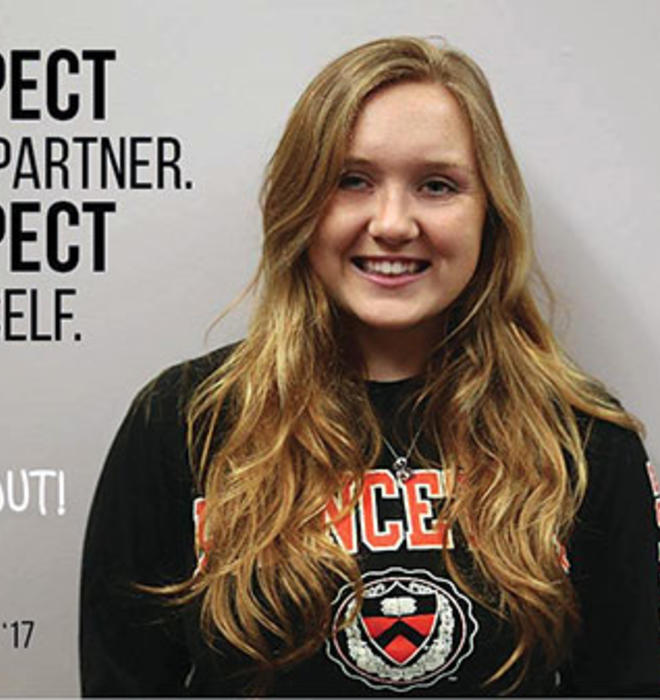
Sexual Misconduct: The New Rules
Changing Policy, Students Say, Is Easier Than Changing the Culture
The images shown throughout this story were taken by Allegra Dobson ’18 for a project organized by SpeakOut Princeton. These and other photos may be viewed on the group’s Facebook page, http://bit.ly/SpeakOutPhotos.
My first stop whenever I go back to campus is the Frist Campus Center — usually to go to the bathroom in the women’s room on the first floor.
And whenever I use this bathroom, I think about sexual violence. That’s in part because there are notices about resources for survivors of it on the insides of the stalls here, as there are in so many Princeton bathrooms. But it’s also because I know that an act of sexual violence was attempted here, in this bathroom, in the big wheelchair-accessible stall, the last stall in the row. In 2005, when I was a freshman, a female student who had been studying in Frist was using the bathroom when her assailant crawled under the stall door and tried to attack her, fleeing only when the student screamed and another student ran to get assistance. I remember reading the woman’s account of the attack and its aftermath, how the sound of a toilet flushing triggered memories of that traumatic experience. On a trip back to campus to do reporting for this story, I think about this as I flush the toilet, wash my hands, and walk back out onto the main floor of Frist.
That assault and others led to the formation of SpeakOut, the student group responsible for the fact sheets I used to see in the bathrooms, stuck in the stalls and on the mirrors, which I read as I brushed my teeth. The signs provided statistics on campus sexual violence and advised women how to decrease the likelihood of assault. They clarified the definition of sexual consent: “Remember your comfort limits, and trust your instincts when you’re in a sexual or potentially sexual situation. No matter how far things have gone, you have a right to change your mind at any time.” In men’s bathrooms, the signs tied definitions of masculinity to prioritizing consent and communicating about sex (“Open communication during sexual encounters is crucial. Most men and women believe that talking about sex does NOT ruin the moment.”). SpeakOut co-founder Sarah Erickson ’07, now a doctoral candidate in communication studies at the University of Michigan, says the signs were not always well-received, and often were taken down or vandalized. Students “didn’t want this cognitive dissonance of like ‘Princeton, Princeton, everything’s great, but I’m peeing and I’m looking at this sign about how things aren’t great. I can’t get away from them,’” Erickson says.
Over the years, SpeakOut’s membership and activities dwindled — until Eliza Mott ’16, as a sophomore, realized that though she had watched a freshman-orientation play dealing with sexual misconduct and other topics, the issue seemed to vanish from her consciousness after that. Assault “was obviously happening, and yet I hadn’t even thought about it for the whole year,” she says. “So I wanted to figure out what I could do to prevent that, because not thinking about it can lead to causing it.” Now the group — with female and male members — is hanging posters in eating-club bathrooms and elsewhere, chalking graffiti on campus walkways, and getting the word out however it can. “Our agenda is to make students aware in a surprising way,” she says, “to sort of force them to engage with the issues.”
Over the last two years, the national conversation about sex on college campuses has shifted from a discussion about the casual, no-strings-attached “hookup culture” — were students having too much sex, or at least the wrong kind of sex? — to one about sexual violence and whether university administrations were failing to properly punish and discourage acts of sexual violation. That transition has taken place in the context of discussions about sexual violence in other institutions, including the armed forces and the NFL.
In June, a poll by The Washington Post and the Kaiser Family Foundation found that 20 percent of young women who attended college during the past four years said they had been sexually assaulted; others reported attempted attacks or suspected they were violated while drunk or otherwise unable to consent. In total, 25 percent of the women and 7 percent of young men said they suffered “unwanted sexual incidents in college.” Alcohol played a large role: Two-thirds of victims in the poll reported they had been drinking just before the incidents. Other risk factors were hookups and the presence of Greek life on campus. (The presence of alcohol makes negotiating consent more difficult, to be sure, but sexual violence takes place in all kinds of settings, and sobriety cannot fully protect students from committing or experiencing assault.)
In the face of strong federal pressure to act, Princeton — one of more than 75 colleges investigated by the U.S. Department of Education’s Office for Civil Rights (OCR) — last year revised its sexual-assault policies, including lowering the standard of proof in disciplinary proceedings and changing aspects of the investigatory process and hearings to provide trained investigators and more support for victims. After a four-year investigation, OCR concluded that Princeton had violated Title IX, which prohibits discrimination on the basis of sex in educational programs that receive federal support, by failing to properly respond to complaints of sexual violence and by not ending a sexually hostile environment for one student. Support for the new policies is not unanimous: Some faculty members, students, and alumni have lamented what they see as a lack of due process for those accused of misconduct, including the use of the “preponderance of the evidence” standard instead of the old “clear and persuasive” standard, and the use of lawyers in the process. An advisory group, the Faculty-Student Committee on Sexual Misconduct, was created to review implementation of the policies and to ensure that students understand their rights under Title IX.
What difference will Princeton’s changes make? Some insight might come soon from the results of a survey conducted at the University last spring. About 4,100 students — 53 percent of graduate students and 52 percent of undergraduates — participated in a 39-question “We Speak” survey focusing on attitudes about sexual misconduct on campus. Among other things, students were asked to respond to detailed questions about how Princeton treats sexual-misconduct complaints, how students respond to reports of misconduct and to situations where others might be in danger, where students would get help, and whether they experienced any of a long list of examples of harassment and misconduct, ranging from sexist remarks or jokes to the use of physical force and unwanted sexual contact. One set of questions concerns “your experiences with unwanted sexual contact while you were unable to provide consent or stop what was happening because you were asleep, passed out, or incapacitated by drugs or alcohol.”
Jed Marsh, Princeton’s vice provost for institutional research, says the survey would provide “perhaps the most comprehensive data on sexual misconduct that we’ve ever had available.” Results are expected to be released this fall. The other Ivies participated in a survey conducted in April at 28 U.S. colleges serving 800,000 students. Those results, too, are planned for release in coming weeks.
Mott, the president of Ivy Club, believes that campus awareness of sexual misconduct has grown dramatically “all around, and within the eating clubs specifically.” Some of the clubs have had workshops presented by SHARE, a University-sponsored peer-advising group. SHARE — which stands for Sexual Harassment/Assault Advising, Resources, and Education — also has increased its presence in the residential colleges, with advisers “routinely attending study breaks, sharing information with RCAs [residential-college advisers] and their respective [advisee] groups, and having a presence in dining halls during meal times,” says Jacqueline Deitch-Stackhouse, the director.
One focus in the Princeton survey and in presentations and informational brochures around the country has been the issue of consent. The Washington Post-Kaiser study found that America’s college students were deeply divided over how to read the signals sent as situations become intimate. That survey posed different scenarios: Someone undresses, gets a condom, or nods in agreement. At least 40 percent of the students in that study believed such activities signaled consent — and about the same number did not.
“Normal, consensual, heterosexual sex on campus has become dangerous for males,” Coy Ozias ’18 wrote in the Prince last December. “The rule used to be ‘no means no.’ That has changed. The new rule is ‘yes means yes.’ The burden of ‘affirmative consent’ has been placed solely on the male. A male must get consent from the female at every stage of their sexual encounter. However, even if he does get consent, he is still at risk if it is determined that the female was under the influence of alcohol or drugs. Even if he himself is intoxicated, it is now his responsibility to assess the intoxication of his partner. The female has none of this responsibility. If a female says that she was raped or assaulted the next day, the male student can face expulsion, even if the sex was consensual and not forced.”
Ozias’ column drew 89 responses in an online discussion about men’s and women’s responsibilities, standards of proof, and the definition of rape.
Many students still are unclear about what it means to give consent for sex, says Isabella Bersani ’16, who now leads SpeakOut. “It’s difficult,” she says. “Everyone is kind of your friend; you go to school with them. People still struggle with where is the line. But the fact that people are using the word [consent] and thinking about the circumstances — I think it will turn into something more serious.”
Bersani thinks the campus conversation has become “more nuanced about the kinds of things you need consent for” — a change she attributes to national media coverage, the role of women in university and student-group leadership positions, and a disturbing incident at Tiger Inn, in which a woman was photographed without her knowledge or consent performing a sexual act on the club’s dance floor, and a photo was distributed — again, without her consent — on the club’s email list. That was a “wake-up call” for students to recognize that Princeton is not immune to sexual misconduct, prompting them to become more thoughtful, she says: “It was hugely important for people to realize that if I want to take a photo of someone and distribute it, you need their permission. It promoted a more diverse conversation.”
Of about a dozen students interviewed by PAW on campus last spring, most were aware of the renewed focus on sexual misconduct and consent, even if they knew little about the policy changes Princeton had adopted. None had noticed a change in the campus dating scene, though some expressed a bit of wariness about attending parties at the eating clubs — “our frats,” as one female student said.
“We are consistently having these conversations on campus,” said Jonathan Hastings ’15, who was a peer adviser. “There have been macro-level changes like the way clubs do bicker, but on the micro level like pre-games and going out on Thursday nights, nothing much has changed.” He believed that students were thinking more about obtaining consent: “It’s definitely more in the forefront of people’s minds. But I don’t think it’s really an issue unless you’re in a gray area.”
J.T. Wu ’16, a Rocky residential-college adviser, believes most male Princeton students are not “more nervous about having sex, per se. More aware of the consequences? Absolutely.” Wu sits on the steering committee of MAVRIC (Men Against Violence Resource and Intervention Community), which was founded in the fall of 2013 to prevent sexual violence by combating the notion that being a man means being violent and domineering.
“More people are realizing that consenting to something five hours before doesn’t override a ‘no’ in the moment,” Wu said. If male students are finding that they need to adjust their behavior, Wu told PAW, that’s because they’re bringing their behavior into line with what’s appropriate — and many students have, until now, been ignorant of what constitutes “appropriate”: “I think students, little by little, are beginning to realize what is acceptable and what really is not.”
Some students said the consent issue is not difficult to navigate. Nicholas Wu ’18 said he believes consent is “a pretty clear line,” and that he and male friends practice what’s called “bystander intervention” — a key aspect of Princeton’s educational program — to look out for other students. “I always try to be aware of it when I’m out at the clubs, like pulling a friend away if it looks like there’s unwanted attention,” he said. Asked about the risks of bystander intervention — violence, social ostracism, awkwardness — he said he wasn’t worried: “The consequence of not doing it is worse.”
And several students seemed to agree that as necessary as Princeton’s policy changes were, changing everyday behavior may prove much more difficult. “What matters is changing what is OK to do and what isn’t OK to do — changing the culture of, say, how to take care of a drunk girl or drunk guy, rather than these legal changes,” said Grace Turner ’18. “It’s very good that they are changing the policy. ... What will bring real change is more social pressure — for example, that it’s not OK to harass drunk girls.”
Walking from the Street to Frist with my notebook pages full of student interviews and observations, I think about these changes. As the national conversation about sex on campus has shifted, Princeton, after considerable external pressure, has shifted with it. Even at Tiger Inn, the winds seem to be changing. The young man found responsible for emailing the dance-floor photograph was removed as a club officer, along with another student who sent an offensive email. And in a recent election, the students of TI elected the club’s first female president.“What we can do going forward is make Princeton the place it should have been” for students in the past, says Dean of the Faculty Deborah Prentice, who has taught at Princeton for 27 years. “If you can’t undo that past, you can at least learn from it.”
Making one last trip to the Frist women’s room before I head down the hill to the Dinky, I scan the now-familiar signs above the hand dryer. I think about the students I’ve talked to and about my friends and classmates who suffered mightily. I think about all the hours of activism and deliberation, the effort and energy required to get the Princeton community — students, faculty, and alumni — to this point: to new awareness, new debates, new policies. And, I hope, to a new culture of sexual ethics.
Mary Hui ’17 contributed to this article.
Later this month, Chloe Angyal ’09 will become senior front-page editor at The Huffington Post.

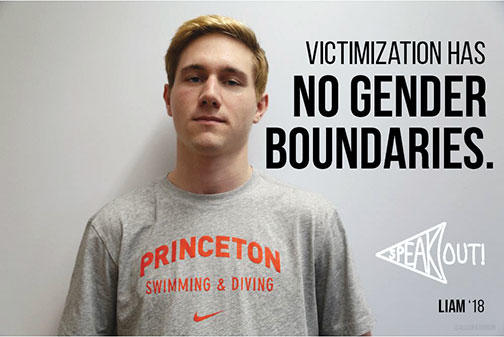
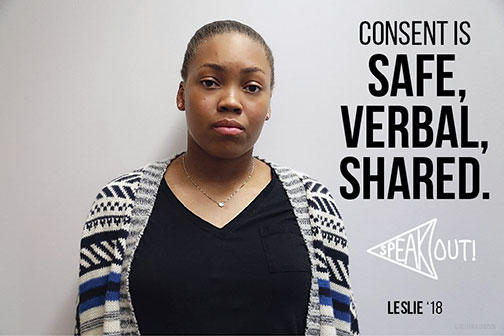
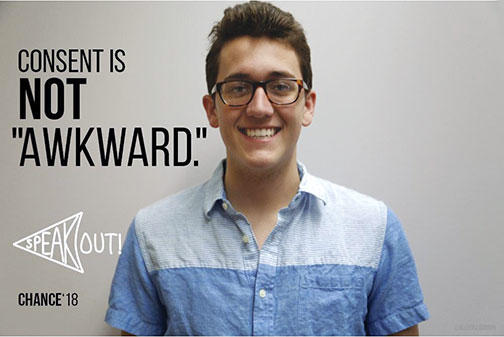
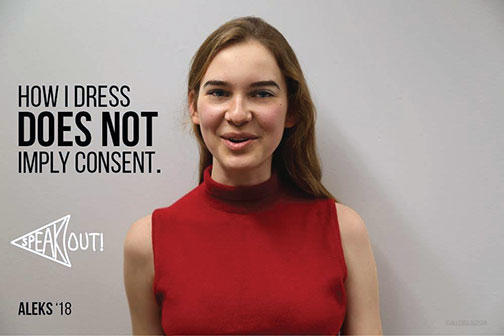


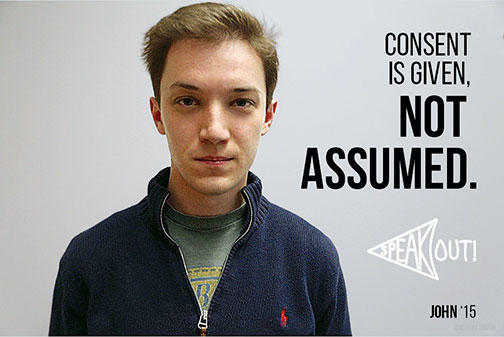
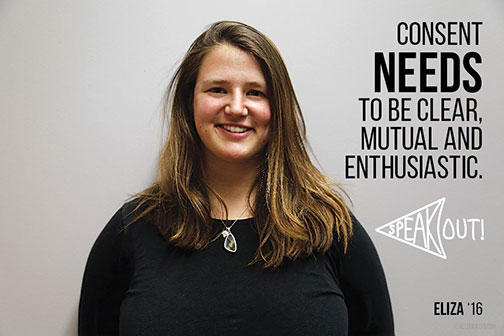
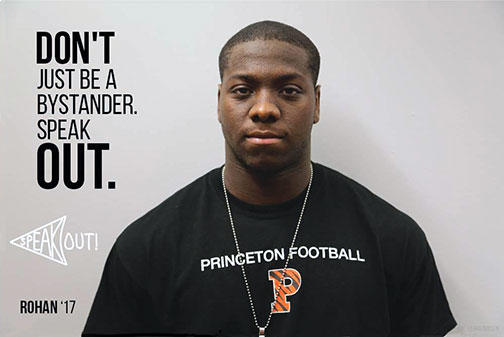
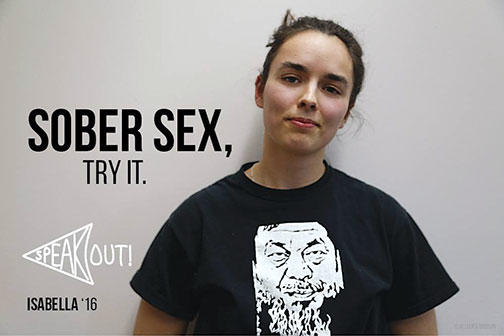
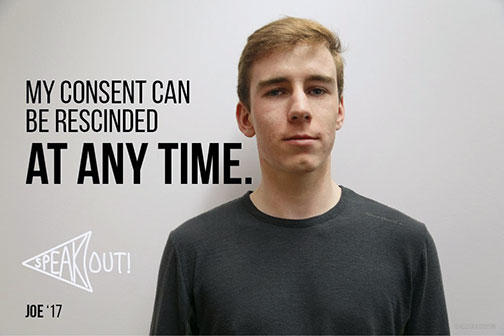




4 Responses
Caitlin La Ruffa ’09
9 Years AgoPreventing Sexual Assaults
I am pleased to see so much thoughtful attention being paid in the pages of PAW to the campus sexual-assault crisis over the last several issues. It’s clear the University is making an effort to address the problem. Yet, in spite of the new layers of bureaucracy, changes in disciplinary procedures, and awareness campaigns, we are still far from making real progress.
These efforts aim less at preventing assaults than at reforming what happens after an assault. The University needs to be willing to bear more of the responsibility for prevention, even at the risk of seeming like a “wet blanket”: Wouldn’t it be better that 10 consensual sexual encounters be avoided than one non-consensual act be committed? Why not move toward practical changes like dormitory check-in counters with guards, single-sex dormitories, and/or dormitory curfews?
As a former SHARE adviser, who for three years led discussions with freshmen after the University’s sexual-assault awareness play “Sex on a Saturday Night,” I saw that the overwhelming message for many students was about the lack of boundaries, rather than about the need for consent. They were entering a world of sex and relationships (treated lightly, even crudely) in which they would be left to their own devices, lacking rules and adult guidance and intervention. The University would be there to comfort and punish, but otherwise was out of the picture. This lack of protective boundaries needs to be remedied if we are to see positive change in the campus culture.
Eva Marie Haine ’11
9 Years AgoPreventing Sexual Assaults
Sexual assault is a frequent subject of dinner conversation in my house. As a prosecutor for the Army, my husband deals with these cases every day. Our discussions give me a closer perspective on the policy issues being debated at Princeton.
“Sexual Misconduct: The New Rules” (feature, Sept. 16) was right to emphasize that “no means no” is not enough. However, a messaging campaign focused on “yes means yes” will still fall short. There is a serious disconnect when we treat sexual assault gravely but otherwise treat sex casually. Students feel enormous pressure to be sexually active at the cost of other principles, including respect of others’ personal rights. These sorts of attitudes also minimize the pain of victims and often discourage them from reporting the assault out of embarrassment for feeling that it actually did matter.
I hope that moving forward, the University will take a cue from student groups like the Anscombe Society and a newer group called The Alternative (both absent from the article) who pose questions beyond consent when it comes to sexual choices. I was never a member of either group, but I, and many others I knew, appreciated the message that consent is necessary, but not sufficient, for a sexual culture that is truly based on respect.
Walter Weber ’81
9 Years AgoAlternative Slogans
The article “Sexual Misconduct: The New Rules” (feature, Sept. 16) included numerous photos from the SpeakOut photos collection. These photos (http://bit.ly/SpeakOutPhotos) bear slogans, the general theme of many of which a wag might characterize as “responsible promiscuity” (e.g., “Sober Sex. Try It” and “Consent. Get Some”). What a refreshing contrast it would be if there were slogans along the following lines:
“I should give you the most intimate access to my body ... because why?”
“No thanks. Condoms don’t shield hearts.”
“The trip from my bathroom to my bedroom is not a ‘walk of shame.’”
“Why should I put steroids into my body so you can have pleasure?”
“No one gets STDs from chastity.”
“Tell me again why letting a guy sleep with me who barely knows me isn’t using me?”
“Test drive a car, not a person.”
Elizabeth Robinson ’94
9 Years AgoBreaking a Silence
It is difficult to find words to express the relief and gratitude I felt upon reading “Sexual Misconduct: The New Rules” (feature, Sept. 16). It has been difficult, for more than 20 years, to find words to articulate my relationship with Princeton, and with who I was, and what I encountered, while a student there. I encountered — and survived — depression, sexual assault, alcohol abuse, and a deep silence, powered by shame. To hear and feel that silence breaking over the past few years in the culture at large, at Princeton, and in myself, has been nothing short of wondrous. I am deeply grateful to all the Princeton students, current and former, of all genders, who are using their voices and bodies to protect and heal. I am also grateful to Dean Deborah Prentice for her strong words: “What we can do going forward is make Princeton the place it should have been” for students in the past. May all beings be safe to live and speak truthfully. May we all grow and learn.